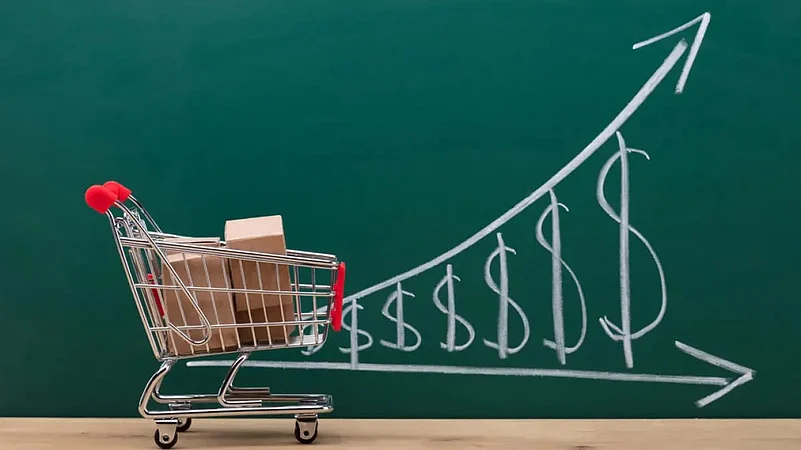The Reserve Bank of India’s (RBI) latest consumer confidence for May has shown that consumer confidence has improved compared to last year, but households’ median inflation perception for the current period has increased by 0.4 per cent at 10.1 compared to March 2022 figures of 9.7. In other words, consumers expect their spending to increase because of inflation.
Though the consumer confidence index has improved and now stands at 75.9, it is still in the negative territory, since consumers are now being pessimistic, the survey revealed. In March 2022, the consumer confidence index was 71.7. Index figures below 100 is considered to be in pessimistic territory, but if the index is above 100, it indicates optimism.
According to the survey, which covered 6,027 responses, households expect their spending to increase in the next one year with expenses on essentials going up while they plan to cut down on non-essential expenditure. “Majority of the households expect general prices and inflation to remain high over three months and one year ahead horizons,” the survey revealed.
The consumer confidence survey by the RBI obtains current perceptions compared to a year earlier and one-year ahead expectations on general economic situation, employment scenario, overall price situation, and own income and spending. The survey was conducted between May 2 and 11.
According to the survey, the expectations for overall price and inflation over the next one year are in sync with those for non-food products and cost of services. In addition, expectations for the three months ahead are generally more aligned to those for food products and non-food commodities.
“Consumer confidence for the current period has been consistently improving since July 2021; the sentiments on the key parameters like employment and household income improved further in the latest round of the survey, though they remained in a pessimistic zone,” the RBI said in a press release.
Inflation Future Expectations

The survey further noted that the majority of households expect general prices and inflation to remain higher for the three-month and one-year period. The future price expectations index value slightly moderated at 113, when compared to March 2022 figures of 115.2.
Incidentally, RBI Governor Shaktikanta Das had also in his ‘monetary policy’ announcement on June 8 said that inflation has been bigger and it has risen faster than what the RBI had estimated in April and May. It is set to remain higher than six per cent till December 2022, mainly due to elevated food prices.
“The Monetary Policy Committee (MPC) notes that continuing shocks to food inflation could sustain pressures on headline inflation. Persisting inflationary pressures could set in motion second-round effects on headline Consumer Price Index (CPI),” Das said in his monetary policy announcement.
While announcing the central bank’s bi-monthly policy decision, Das had said that the MPC had raised the CPI inflation projection for the financial year 2023 to 6.7 per cent from the 5.7 per cent estimated earlier. This was above the RBI’s inflation target of 4 per cent. The central bank is required to maintain the CPI at 4 per cent, with some room to hit the upper limit at 6 per cent and the lower limit 2 per cent.
The RBI has further projected the CPI inflation for the first quarter of FY23 at 7.5 per cent against 6.3 per cent earlier, while it has estimated it at 7.4 per cent against the 5.8 per cent projected earlier for the second quarter. For the third and fourth quarters, the CPI inflation is projected at 6.2 per cent and 5.8 per cent, respectively.
Das had said that since the MPC’s previous meeting in May 2022, the global economy has continued to grapple with multi-decadal high inflation and slowing growth, persisting geopolitical tensions and sanctions, elevated prices of crude oil and other commodities, and lingering COVID-19 related supply chain bottlenecks.
The RBI has further said that 75 per cent of this massive increase in inflation projections could be attributed to the food basket.
“CPI headline inflation rose further from 7.0 per cent in March 2022 to 7.8 per cent in April 2022, reflecting a broad-based increase in all its major constituents. Food inflation pressures accentuated, led by cereals, milk, fruits, vegetables, spices and prepared meals,” the survey said.
Apparently, as food inflation in India continues to rise, the prices of vegetables, such as tomatoes have also doubled in major cities within a year. In Mumbai and Kolkata, it is Rs 77 per kg as against Rs 28 and Rs 38 a kg a year ago
According to the survey, the following are the various variables and consumers’ one-year ahead expectations when compared with the current situation:
Economic Situation: In March 2022, the economic situation index was at 13.5, and in May 2022, it was at 6. This shows that there is a positive sentiment among consumers, but with deterioration when compared with the previous round of the survey.
Price Level: In March 2022, the price level index was at 68.6, while in May 2022 it was at 71.7. This shows that there is a negative sentiment with signs of deterioration when compared with the previous round held in March 2022.
Employment: In March 2022, the employment index was at 22.7, while in May 2022 it was at 19.2. This shows that there is a positive sentiment among consumers, but with deterioration when compared with the previous round, the survey revealed.
Spending: In March 2022, the spending index was at 64.1 and in May 2022 it was at 66.7. This shows that consumer sentiments were improved when compared with the previous round of survey.
Income: In March 2022, the spending index was at 44.3, while in May 2022, it was at 44. This shows that there is a positive sentiment among consumers, but with deterioration when compared with the previous round.














